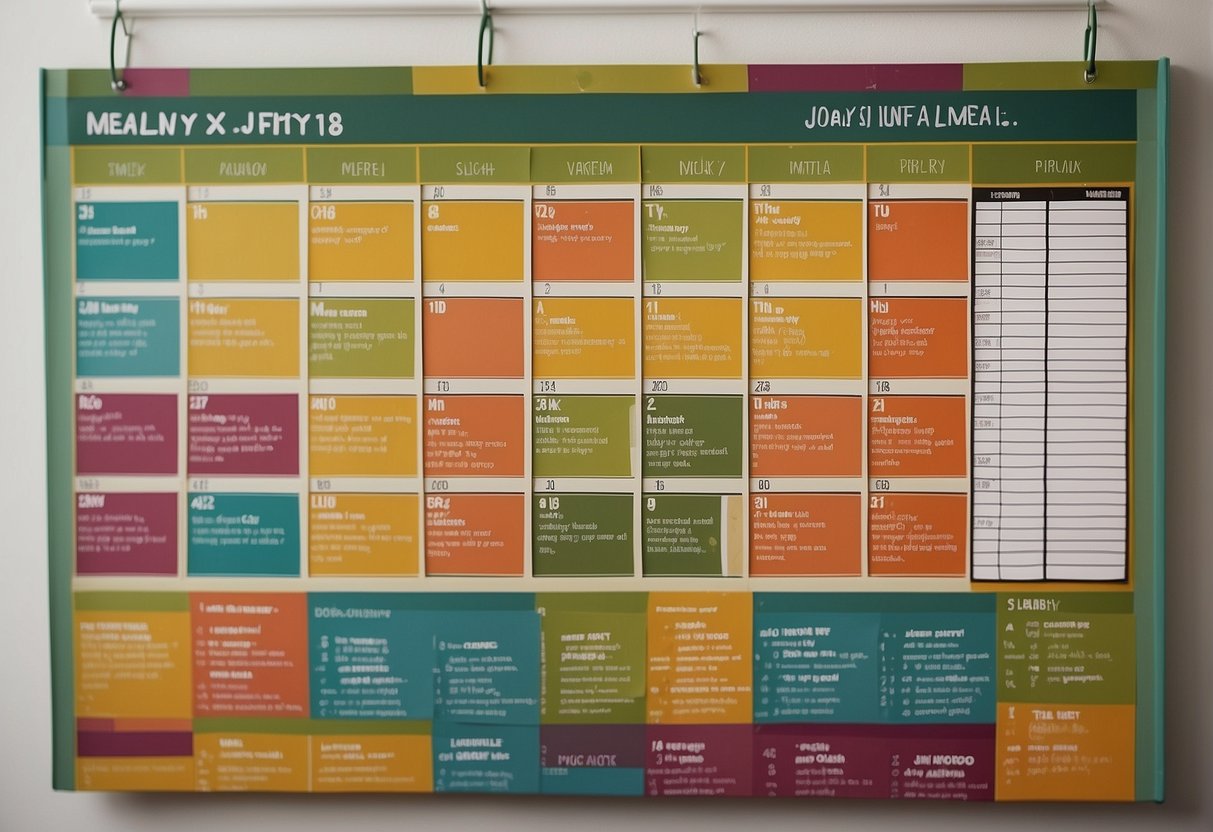Embarking on a 12 week 5K training plan is a strategic approach for runners of all levels to improve their endurance, speed, and overall running performance. Whether a beginner aiming to complete their first race or an advanced runner looking to set a new personal best, this structured regimen offers a progressive buildup of intensity and volume.
By allocating three months to training, individuals give their bodies ample time to adapt to the demands of running a 5K. This reduces the risk of injury and ensures consistent improvement.

The success of a 12 week 5K training plan hinges on a comprehensive approach that integrates various elements beyond running. To tailor the plan effectively, one must assess one’s current level of fitness.
Throughout the program, runners will experience a variety of workouts designed to challenge different aspects of fitness.
Adequate rest and recovery are as crucial to the plan as the workouts, providing the body time to heal and grow stronger.
Nutrition and cross-training also play pivotal roles in supporting the body through the increased physical demands. Meanwhile, regular tracking of progress allows for necessary adjustments, ensuring continual advancement towards the goal.
Key Takeaways
- Tailoring the plan to the runner’s fitness level ensures personal relevance and effectiveness.
- A balanced training approach includes various workouts, rest days, and cross-training.
- Monitoring progress throughout the plan allows for adjustments and sustained improvement.
Quick Navigation
Getting Started With Your 12 Week 5k Training Plan

Embarking on a 12-week 5K training plan is an exciting venture. This beginning stage is crucial for establishing a solid foundation that will carry a runner through to the finish line.
Whether one is a complete beginner or has some experience, understanding where to start, how the plan is structured, and the importance of setting a specific goal, is paramount in the first days and weeks of training.
Assessing Your Current Fitness Level
Assessing one’s current fitness level helps tailor the training plan to individual needs.
This might involve determining if complete beginners can comfortably walk for 20 minutes. Meanwhile, those with some running experience might evaluate their current pace over short distances.
Understanding where one is starting will ensure that one begins training at the appropriate intensity.
Understanding the Training Plan Structure
An apparent comprehension of the training plan structure is key to success.
Typically, a 12-week plan is segmented into various workouts, including easy runs, interval training, long runs, and cross-training, spreading across different days of the week.
Each workout serves a specific purpose: building endurance, improving speed, and promoting recovery.
Setting a Specific Goal for Your 5K
Goal setting is essential, giving a runner something concrete to strive for.
A specific goal for a 5K could range from simply finishing the race to achieving a personal best.
For a complete beginner, the initial goal may be to run the entire distance without walking, while more experienced runners might aim for a particular time.
Having a clear target from the outset provides direction and motivation throughout the weeks of training.
12 Week 5k Training Plan: Week-By-Week Training Breakdown

This section offers a detailed 12 week 5k training plan that transitions from foundational building to higher-intensity training and finally to race preparation.
The First Four Weeks: Building a Base
In the initial phase, the runner establishes a routine and builds endurance. They should start with short to moderate distances at a comfortable pace, gradually increasing the time spent running.
Week 1:
- Monday: Rest
- Tuesday: Run for 15 minutes at an easy pace
- Wednesday: Rest
- Thursday: Run for 15 minutes at an easy pace
- Friday: Rest
- Saturday: 20-minute brisk walk
- Sunday: Run for 20 minutes at an easy pace
Week 2:
- Gradual increases in running time to 20 minutes
- Introduce a 2-minute jog and 2-minute walk interval session
Week 3:
- Alternate days of easy running with rest or cross-training
- Introduce a 25-minute continuous run
Week 4:
- Continue with three days of running, interspersed with cross-training
- Ensure one run includes longer durations at an easy pace
Weeks 5-8: Introducing Longer Runs and Speed Work
During this phase, the runner integrates longer runs and essential speed work into their weekly routine.
Week 5:
- Include one long run, starting at a distance comfortable for the runner
- Include a session of mile repeats at a higher speed with rest intervals
Week 6:
- Extend the length of the long run by 5-10 minutes
- Begin hill training sessions to build strength and speed
Week 7:
- Longer runs should now reach at least half the 5k distance
- Speed sessions evolve with shorter rest periods between high-intensity bursts
Week 8:
- Continue to extend the long run by small increments
- Speed training includes intervals at race pace with short recoveries
Weeks 9-12: Tapering and Final Preparation
Training intensity peaks before tapering for the 5k race in the final weeks.
Week 9:
- Peak long run distance, aiming close to or at the 5k length
- Introduce a training session featuring a race-pace effort
Week 10:
- Begin reducing the volume of the training sessions
- Maintain intensity with the inclusion of a next workout of high-speed intervals
Week 11:
- Continue tapering with shorter sessions, focusing on maintaining speed
- Include one moderate long run early in the week and then rest
Week 12:
- Several days before the race, perform a final short, sharp workout
- Prioritize rest with light jogging and dynamic stretching to keep muscles active
12 Week 5k Training Plan: Incorporating Rest and Recovery
In any 12 week 5K training plan, integrating rest days and respecting recovery time are crucial components to prevent injury risk and to ensure overall health and progress during training.

Scheduling Rest Days
In the context of a 12 week 5k training plan, rest days should be strategically placed following intense workout sessions or long runs.
Ideally, one to two days of rest per week allows the body to repair and strengthen itself.
Many running coaches include a down week every fourth week, during which the training volume decreases by 10-40%.
Understanding the Importance of Recovery Time
Recovery time is not merely a pause from training; it is an active phase in the training cycle that allows muscles to repair and reduces the risk of injury.
Even experienced runners must acknowledge that their bodies are not machines; rest is not negotiable.
Verywell Fit emphasizes the need to build rest and recovery into any training regimen to prevent injuries and maximize the effectiveness of training sessions.
12 Week 5k Training Plan: Nutrition and Cross-Training Strategies

A comprehensive 12 week 5K training plan must include proper nutrition for energy and recovery and a cross-training regimen that enhances overall fitness without overtaxing running-specific muscles.
Fueling Your Body for Optimal Performance
Nutrition plays a pivotal role in a runner’s performance and recovery.
During a 12-week training cycle, an individual’s calorie burn increases, necessitating a more focused approach to food intake.
For sustained energy, meals should be balanced with complex carbohydrates, lean proteins, and healthy fats.
A strategic approach could involve consuming a 12-ounce Super Smoothie packed with greens, fruits, protein powder, almond milk, and a source of healthy fats like avocado or cashews.
- Complex Carbohydrates: Quinoa, brown rice, whole-grain pasta
- Lean Proteins: Chicken breast, tofu, legumes
- Healthy Fats: Fish oil, nuts, seeds
Ensuring hydration is maintained is critical, too. Water intake must be consistent throughout the day, emphasizing hydrating before and after workouts.
Cross-Training Options for Non-Running Days
Cross-training days are crucial to a successful training plan. They reduce the risk of overuse injuries and improve cardiovascular fitness.
Options for non-running days should include activities that complement running. They should strengthen different muscle groups and provide variability in the exercise routine.
Strength Training Workout: Strength training is beneficial as it targets muscles that are not commonly used during running, improving overall muscular balance. A routine might consist of bodyweight exercises such as squats and lunges or resistance training with weights, both of which are effective for building strength.
- Bodyweight Exercises: Squats, lunges, push-ups
- Resistance Training: Free weights, resistance bands
Other cross-training activities can include cycling, swimming, or elliptical training. These are excellent for maintaining cardiovascular endurance while giving the joints a break from the impact of running.
12 Week 5k Training Plan: Tracking Progress and Adjusting the Plan

Successfully training for a 5K involves careful monitoring of one’s progress and the willingness to adjust the training plan as necessary. Precision in both tracking and tweaking ensures a tailored and practical training experience.
Using Progress-Tracking Tools
A variety of progress-tracking tools are available to runners, each offering unique insights into their training journey. Tools like TrainingPeaks Premium provide detailed analysis and are compatible with various devices, including smartphones and GPS watches.
Runners can view comprehensive metrics like pace, distance, heart rate, and more, allowing them to make data-driven decisions.
- Key Features to Look for in Progress-Tracking Tools:
- Compatibility with multiple devices
- Detailed workout analysis
- Customizable views and reports
When to Modify the Training Plan
A runner should modify their specific plan when certain conditions arise. If progress plateaus or regresses, unexpected injuries occur, or life events occur, it may be time to consider a plan of equal value that better suits their current situation. It is essential to reassess the training plan regularly, ensuring it remains challenging yet achievable to support improved performance continuously.
- Indicators for Plan Adjustment:
- Lingering fatigue or diminished performance
- Consistent failure to complete workouts
- Life events affecting the training schedule
- Signs of overtraining or injury
12 Week 5k Training Plan: Conclusion

In completing a 12 week 5K training plan, individuals can experience a structured and progressive approach to building endurance and speed. The plan typically starts with moderate-intensity workouts and gradually increases in volume and intensity.
Runners can expect various training sessions, from easy runs to intervals and long-distance jogs. Each is sequenced to optimize performance.
Successful completion of the training plan hinges on consistency and adherence to the prescribed workouts. They are designed to improve physical prowess and enhance mental tenacity, preparing runners for the physical and psychological demands of race day.
Runners should also prioritize rest and nutrition, critical components of any training regimen. Adequate recovery and a balanced diet support the body’s healing processes and provide the energy required for each training phase.
By the end of the 12 weeks, runners who have fully invested in the plan should feel prepared to tackle the 5K distance confidently. While individual results may vary, the progressive nature of a 12 week 5k training plan ensures that runners of all levels have a solid foundation to perform to the best of their ability.


